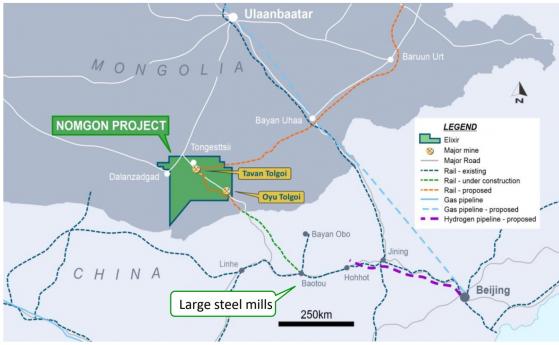Elixir Energy Ltd (ASX:EXR) is focused on developing Gobi H2 - Mongolia’s first green hydrogen project (i.e. one where hydrogen is produced from renewable electrical energy sources).
The company’s rationale behind the Gobi H2 project is that producing green hydrogen in Mongolia and piping it to China is more energy efficient than transmitting power to China for hydrogen production.
The strength of the concept behind the project was demonstrated in mid-2022 when Elixir announced the signing of a memorandum of understanding (MOU) over Gobi H2 with Japan’s SB Energy Corp (now Terras Energy – 85% owned by Toyota Tsusho Corp).
Elixir procured a pre-feasibility study (PFS) from global consulting firm AECOM earlier this year to give the parties the confidence to advance the project – they are now aiming to enter into a binding JV later this year.
The PFS evaluated various configurations of wind, solar, battery and a grid connection to support a 10 MW (megawatt) electrolyser located at a site proximate to Terras Energy’s existing operated wind farm in the South Gobi region.
Emerging regional hydrogen infrastructure
The location of the Gobi H2 project provides ready access to the rapidly growing Chinese hydrogen markets.
Elixir commissioned a ‘Hydrogen in China’ market study from global energy consultants Rystad Energy which concluded “the scale of ramp up will likely open up imports from beneficial production sites like Elixir’s”.
Regional hydrogen transmission infrastructure is already emerging, including Sinopec’s recent announcement of a 400-kilometre hydrogen pipeline in inner Mongolia.
Advantages of pipeline
Around two-thirds of the cost of producing green hydrogen is the cost of renewables.
The table illustrates that Gobi H2 has the best combined renewable energy capacity factor amongst what are considered to be world-class locations (as measured by electrolyser utilization under certain standardization assumptions).
Shipping hydrogen by boat costs multiples (~$20/GJ) of shipping the same energy as methane (~$5/GJ).
The delivered cost of hydrogen is therefore all about the quality of renewable energy and the cost of delivery.
Access to markets by pipeline is massively advantaged over seaborne supplies – Elixir has the potential to supply hydrogen from Mongolia to Chinese markets by pipeline.
Cost of gas-to-gas hydrogen transportation, including conversion and reconversion - 2030s (for hydrogen production of ~15PJ/year).
Hydrogen has traditionally only been used in niche markets such as oil refineries – and has generally been produced from fossil fuels, with resultant large CO2 emissions.
The more recent pursuit of green and blue hydrogen (the latter is still derived from fossil fuels but the CO2 emissions are captured and stored underground) is driven solely by emission reduction aims.
Globally this is recognized by emerging standards that must be met for hydrogen to be deemed green or blue – each major jurisdiction is developing its own rules, but these are converging towards targets based on maximum CO2 emissions per kg of H2 produced.
Unless a green H2 project can meet these targets – it does not meet its intrinsic aims.
Projects which involve grid connections to electricity systems with still significant fossil fuel use (especially for production on the margin) may well struggle to be deemed green.
Elixir’s analysis illustrates that the Gobi H2 pilot project meets the green definitions of the main global jurisdictions – including China.
This will be critical to procure customers and project finance support.
Read more on Proactive Investors AU
